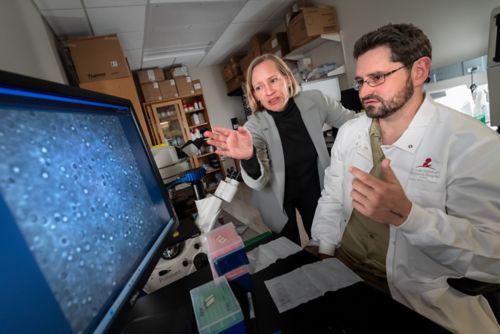St. Jude Family of Websites
Explore our cutting edge research, world-class patient care, career opportunities and more.
St. Jude Children's Research Hospital Home

- Fundraising
St. Jude Family of Websites
Explore our cutting edge research, world-class patient care, career opportunities and more.
St. Jude Children's Research Hospital Home

- Fundraising
Within cells lie membraneless hubs of concentrated proteins and nucleic acids called biomolecular condensates. Like liquid droplets, these condensates are centers of reaction for the spatial organization of biomolecules. Beyond cellular organization, these condensates play roles in disease, including neurodegenerative diseases such as amyotrophic lateral sclerosis (ALS) and frontotemporal dementia.
Understanding how these reaction hubs function and change over time is key to better understanding the mechanisms that drive disease. Studies of biomolecular condensates have uncovered layers of complexity, including their changing material properties, known as “aging.” In these aging processes, the condensates change from having viscoelastic-liquid properties into a viscoelastic solid over time.

Tanja Mittag, PhD, and Wade Borcherds, PhD, Department of Structural Biology, studied the interaction networks within biomolecular condensates to better understand and define these unique material properties.
To better understand these changing material properties, St. Jude scientists, in collaboration with the State University of New York at Buffalo and Washington University at St. Louis, studied the interaction networks within condensates to better understand the rules associated with their unique material properties. The study was published in Nature Physics.
“Condensates have often been described as liquid-like, but their material properties can vary quite a bit,” says co-corresponding author Tanja Mittag, PhD, Department of Structural Biology. “That depends on the sequences of the proteins within them and the lifetime of the interactions being formed.”
Mittag leads an effort to understand how the amino acid sequence of proteins that form these biomolecular condensates determine these material properties through the St. Jude Research Collaborative on the Biology and Biophysics of RNP Granules. Previous work published in Science established a “stickers-and-spacers” model for predicting phase separation behavior in proteins. “Stickers” are amino acids that connect with other stickers, while “spacers” are amino acids necessary for the arrangement of stickers and interactions with water.
Building upon this “sticker-and-spacers” model, the researchers found that the material behavior of biomolecular condensates depends on the strength of these sticker-sticker interactions.
“What we call ‘sticker’ amino acids make pairwise interactions that form a network fluid,” Mittag said. “Now, we understand that these pairwise contacts that are forming — how stable they are and what their lifetime is — determine the condensates’ viscoelastic properties, and we can push their behavior toward elastic properties if we make stronger interactions. We now understand the protein sequence encodes this.”
The team’s work further explored how condensates age, identifying a new path in aging by building on the “stickers-and-spacers” model.
“If we exchanged spacer amino acids for ones that like to interact more with water, we could get condensates to age into a viscoelastic solid,” says co-first author Wade Borcherds, PhD, Department of Structural Biology. “This is like putty becoming a rubber ball. They can both bounce, but one is solid, and one is not.”
Now that the scientists understand how the aging process is encoded in the protein sequence, they can test whether this is the basis for certain neurodegenerative diseases’ development.